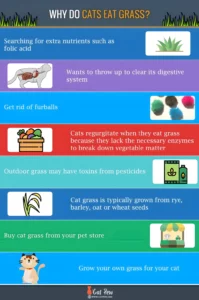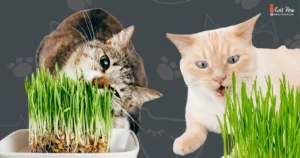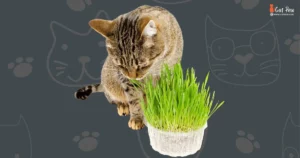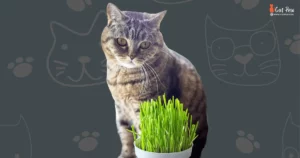1.Why Do Cats Eat Grass When They Feel Sick
Cats eat grass when they feel sick due to its instinct to induce vomiting and expel hairballs or other irritants from their stomach. This article will explore the reasons behind this behavior and provide insights into the potential health benefits and risks associated with cats consuming grass.
Understanding why cats eat grass in times of sickness can help pet owners better care for their feline companions and potentially identify underlying health issues. By observing and addressing this behavior, cat owners can ensure the overall well-being of their pets.
So, let’s dive into this fascinating feline behavior and explore the reasons behind cats’ grass-eating habits.
2.Reasons Why Cats Eat Grass

It’s a common sight to see cats nibbling on grass, and while it may seem unusual, there are several reasons why they engage in this behavior. From fulfilling an instinct to aiding their digestive system, cats have specific motives for consuming grass when they feel sick. Below are the three main reasons why cats eat grass:
Natural Instinct
One of the primary reasons why cats eat grass is rooted in their instinct. Domestic cats may appear far removed from their wild ancestors, but they still possess many innate behaviors. In the wild, felines consumed grass to supplement their diet, providing essential nutrients like folic acid and fiber that were deficient in their prey. This instinctual behavior can persist even in domesticated cats, as they retain this innate desire to consume vegetation.
Digestive Aid
Another important reason why cats eat grass is to aid their digestion. Cats are obligate carnivores, meaning their digestive systems are designed to process animal-based protein. However, they may occasionally struggle with hairballs or indigestion. In such cases, consuming grass can act as a natural way to promote vomiting, allowing them to expel any indigestible material, including hairballs. By triggering this regurgitation response, cats can alleviate discomfort and restore balance to their digestive system.
Purging Parasites
The third reason why cats eat grass is to purge parasites from their system. Parasites such as worms can be troublesome for cats, causing a range of health issues. Eating grass can stimulate the cat’s digestive system, encouraging the expulsion of these parasites. Additionally, grass acts as a natural fiber that can help move worms and other unwanted parasites through the digestive tract, enhancing the overall efficacy of deworming treatments.
Next time you catch your feline companion munching on grass, remember that it’s natural behavior. Whether driven by their instinctual nature, the need for digestive aid, or the desire to rid themselves of parasites, cats have valid reasons for indulging in this seemingly peculiar habit.
3. Health Benefits Of Cats Eating Grass

When it comes to our feline friends, sometimes their behavior can leave us scratching our heads in confusion. One common perplexity for cat owners is their tendency to munch on grass when feeling under the weather. But did you know that this strange habit offers multiple health benefits for our furry companions? Let’s take a closer look at some of the reasons why cats eat grass when they feel sick.
Improves Digestion
One of the main health benefits of cats eating grass is that it improves their digestion. You might be surprised to learn that grass contains a fiber called folic acid, which is known for its positive effects on the digestive system. When cats consume grass, it acts as a natural laxative, helping to move hairballs and other indigestible materials through their digestive tract.
Relieves Constipation
Cats can experience constipation from time to time, and eating grass can be an effective way for them to find relief. Grass acts as a gentle irritant to their intestinal walls, stimulating the contraction of muscles and promoting bowel movement. By nibbling on grass, cats can alleviate discomfort caused by constipation and restore regularity to their digestive system.
Detoxifies Their System
In addition to aiding digestion and relieving constipation, eating grass also helps to detoxify a cat’s system. Cats are notorious for their grooming habits and often ingest fur during their self-care routines. As they groom, hairballs can form in their digestive tract, posing a risk for obstructions. By consuming grass, cats induce vomiting, effectively expelling any accumulated fur along with other toxins from their system.
So, the next time you catch your cat nibbling on grass, don’t discourage the behavior. Instead, cherish the fact that they are taking proactive steps to improve their health. Just make sure the grass they have access to is safe and free from pesticides or other potential hazards. Allowing your cat to indulge in this instinct aids their digestion, relieves constipation, and ensures their system stays free from toxins – all essential for their overall well-being.
4. Types Of Grass Cats Prefer

When cats feel sick or experience digestive discomfort, one peculiar behavior they exhibit is eating grass. Cats have an instinct to consume grass to induce vomiting and cleanse their digestive system. But have you ever wondered what types of grass cats prefer? Let’s take a closer look at some of the common grasses, wheatgrass, and barley grass that often appeal to their feline taste buds.
Common Grasses
Cats typically have a preference for various common grasses. These grasses are easily found in gardens, lawns, or even potted plants, providing cats with a readily available natural remedy for their digestive issues. Some common grasses that cats are often attracted to include:
- Timothy grass
- Fescue grass
- Bluegrass
These grasses are rich in fiber and help cats in numerous ways. Firstly, the texture of the grass aids in removing hairballs from their stomachs, promoting healthy digestion. Additionally, the high fiber content can act as a natural laxative, easing any constipation or indigestion that the cat may be experiencing.
Wheatgrass
Another type of grass that cats find appealing is wheatgrass. Wheatgrass, also known as Triticum aestivum, is nutrient-dense and offers various health benefits for both humans and cats. With its vibrant green color and slightly sweet taste, wheatgrass acts as a natural detoxifier, aiding in the purification of the digestive system.
Wheatgrass contains abundant essential vitamins, minerals, and amino acids, making it a highly nutritious choice for cats. The chlorophyll in wheatgrass acts as a natural deodorizer, helping to freshen your cat’s breath and reducing any unpleasant odors that may arise from its digestive discomfort.
Barley Grass
Barley grass is yet another favored choice among cats when it comes to grazing. Loaded with vitamins, minerals, and enzymes, barley grass provides a valuable source of nutrition for cats. This nutrient-rich grass assists in maintaining a healthy immune system in felines.
Moreover, barley grass contains a range of antioxidants that help combat free radicals and prevent cell damage. By including barley grass in their diet, cats can experience improved digestion, reduced inflammation, and enhanced overall well-being.
So, the next time you notice your furry friend nibbling on grass, don’t be alarmed. Cats instinctively seek out specific grasses, such as common grasses, wheatgrass, and barley grass, to alleviate their discomfort and promote a healthy digestive system. Providing access to these grasses can help support your cat’s well-being and ensure they are well-equipped to deal with any digestive issues that may arise.
5. How To Provide Grass For Cats

If you have ever noticed your feline companion nibbling on grass when they feel sick, you might be wondering why they do so. Cats eating grass is a common behavior and often, it serves as a natural remedy to alleviate discomfort. Fortunately, there are several ways to provide grass for your cat, both indoors and outdoors.
Planting Grass Indoors
If you prefer to have an indoor solution for your little furball, planting grass indoors is an easy and convenient option. By doing so, you not only provide a natural source of nutrients for your cat but also help satisfy their instinctual need to chew on greens. Here’s how you can go about it:
- Choose a suitable container: Select a shallow and wide container that is large enough for the grass to grow and for your cat to reach.
- Pick the right grass seeds: To ensure the health and safety of your cat, it’s essential to choose grass seeds that are specifically meant for cats. These seeds can be easily found at your local pet store or online.
- Prepare the soil: Fill the container with potting soil or a mixture of soil and compost, leaving some space at the top for the seeds to germinate.
- Sow the seeds: Sprinkle the grass seeds evenly across the soil surface, pressing them gently into the soil, and cover them with a thin layer of soil.
- Water the seeds: Using a spray bottle, lightly mist the seeds and soil. Be careful not to overwater, as excessive moisture can lead to mold growth.
- Place in a well-lit area: Find a sunny spot in your home to place the container, where the grass can receive sufficient sunlight. Remember to rotate the container occasionally to ensure even growth.
- Monitor and trim: Keep an eye on the grass, making sure it remains moist but not waterlogged. Once the grass has reached a desirable height, you can trim it slightly to encourage fuller growth.
Buying Cat Grass From Pet Stores
If you are short on time or lack a green thumb, purchasing ready-to-use cat grass from pet stores is a convenient solution. These pre-grown grass products are specially formulated for cats, ensuring they contain the essential elements that your feline friend needs. Here’s what you need to know:
- Choose the right type: Look for cat grass varieties such as wheatgrass, oatgrass, or barley grass. These options are safe and favored by most cats.
- Check for organic options: Opt for organic or pesticide-free cat grass to minimize the risk of exposing your cat to harmful chemicals.
- Follow the package instructions: Each product may have specific instructions for watering and care. Be sure to read and follow them accordingly to maintain the grass’s vitality.
- Present it to your cat: Place the purchased cat grass in a suitable container or simply let your cat have direct access to it. Observe and ensure your cat safely indulges in their green treat.
Growing Grass In Pots Or Trays
If you enjoy a hands-on approach and want more control over the growing process, growing grass in pots or trays is an excellent option. This method allows you to experiment with different grass varieties and create a custom experience for your cat. Here’s how you can get started:
- Choose the right container: Select a pot or tray with drainage holes to prevent overwatering and root rot.
- Prepare the soil: Fill the container with potting soil or a mixture of soil and compost, leaving some space at the top for the grass to grow.
- Sow the seeds: Sprinkle the grass seeds evenly across the soil surface, pressing them gently into the soil.
- Water the seeds: Carefully water the seeds, ensuring the soil is moist but not soaking wet.
- Place in suitable conditions: Find a well-lit area or a sunny spot to place the container. Keep in mind that cats are attracted to warmth and sunlight.
- Provide proper care: Maintain the right moisture level by watering as needed and occasionally misting the grass to promote healthy growth.
- Offer supervised access: Once the grass has grown to a suitable height, allow your cat to enjoy it under your supervision.
Now that you know how to provide grass for your precious feline, you can ensure they have a safe and accessible source of greens. Whether you choose to plant grass indoors, buy cat grass from pet stores, or grow it in pots or trays, your cat will be grateful for this simple yet essential addition to their environment.
6. Precautions When Cats Eat Grass

Cats often eat grass when they feel sick as a way to induce vomiting and get rid of any unwanted substances in their stomachs. It’s an instinct for them, but precautions should be taken to ensure the grass is safe from pesticides or other chemicals that could harm them further.
Avoid Toxic Grasses
One important precaution when it comes to cats eating grass is to avoid toxic grasses. While it is natural for cats to nibble on grass to help with their digestion and to induce vomiting when they feel sick, certain types of grass can be harmful and even poisonous to them. It is essential to make sure that the grass your cat has access to is safe for consumption. Here are some examples of toxic grasses that should be avoided:
- Lily of the Valley
- Daffodil
- Tulip
- Lily
Why is it important to avoid these grasses? These grasses contain toxins that can cause various health issues in cats, ranging from mild symptoms like gastrointestinal upset to more severe complications that could even be life-threatening. It is crucial to be aware of the plants and grasses in your environment so that you can ensure your furry friend’s safety.
Limit The Quantity Of Grass
While grass can be beneficial for cats, it is essential to limit the quantity they consume. Too much grass intake can lead to stomach upset and even vomiting. It is recommended to monitor your cat’s grass-eating habits and provide them with a moderate amount. Keep in mind that every cat is different, and what works for one may not work for another. How to limit the quantity effectively? If you notice that your cat tends to eat excessive amounts of grass, you can try the following measures:
- Supervise your cats when they are outside or provide them with controlled access to grass.
- Trim the grass in your yard to a shorter length, making it less appealing for your cat to consume large quantities.
- Offer your cat alternative activities or toys to keep them distracted and reduce their desire for excessive grass consumption.
Watch For Any Adverse Reactions
It is crucial to watch for any adverse reactions or unusual behavior in your cat after they have consumed grass. While most cats can tolerate grass without any problems, some may experience adverse effects. Here are some signs to look out for:
- Excessive drooling
- Lethargy
- Vomiting that persists beyond a few minutes
- Loss of appetite
What to do if you observe these signs? If you observe any of these signs or any other concerning symptoms after your cat has eaten grass, it is vital to consult your veterinarian for guidance. They can assess your cat’s condition and provide appropriate advice and treatment if necessary. Remember, being attentive to your cat’s behavior and promptly addressing any concerns can help ensure their well-being.
7. Alternative Options For Cats

When it comes to finding alternatives for cats to self-medicate when they feel sick, there are a few options that can help. Cats, known for their curious nature, often turn to grass when they have an upset stomach. However, other alternatives can provide relief without the need for potentially harmful grass consumption. In this article, we will explore two cat-friendly options: providing catnip and offering cat-friendly houseplants.
Providing Catnip
Catnip, also known as Nepeta cataria, is a plant that belongs to the mint family. It contains a chemical compound called nepetalactone, which triggers a euphoric response in most cats. Providing catnip to your feline friend can offer both mental and physical stimulation, helping them feel better when they are under the weather.
There are different ways to provide catnip to your cat:
- Sprinkle dried catnip on their toys or scratching posts.
- Place a catnip-filled toy in their favorite play area.
- Use catnip sprays or essential oils to scent their bedding or play area.
However, it’s important to note that not all cats respond to catnip. Approximately 30% of cats do not exhibit a reaction to catnip due to genetics. If your cat doesn’t respond to catnip, don’t worry; there are other options to explore.
Offering Cat-friendly Houseplants
Another alternative option for cats is offering cat-friendly houseplants. These plants can provide various benefits to cats, including improving their indoor environment, stimulating their instincts, and even aiding digestion.
Here are a few cat-friendly houseplants to consider:
| Plant Name | Benefits for cats |
|---|---|
| Spider Plant (Chlorophytum consumed) | Safe and non-toxic, helps with digestion |
| Cat Grass (Dactylis glomerata) | Aids digestion and provides essential nutrients |
| Valerian (Valeriana officinalis) | The calming effect helps reduce stress and anxiety |
By incorporating these cat-friendly plants into your home, you can provide your feline companion with a safe and natural alternative to grass consumption. However, it’s important to ensure that the plants you choose are non-toxic to cats, as some plants can be harmful if ingested. Always research the safety of plants before introducing them to your cat’s environment.
Remember, each cat is unique, and their preferences may vary. It’s essential to observe your cat’s behavior and consult with a veterinarian to determine the best alternative options for your furry friend.
Conclusion Of Why Do Cats Eat Grass When They Feel Sick?
The act of cats eating grass when they feel sick may seem strange, but it serves a purpose. Grass contains enzymes that help cats induce vomiting, allowing them to expel any substances that may be causing discomfort in their digestive system.
It also acts as a natural laxative, aiding in the smooth passage of hairballs. While it’s essential to monitor your cat’s behavior and consult with a veterinarian if any concerning symptoms persist, allowing them access to safe grass can be a beneficial way to support their overall well-being.
Frequently Asked Questions For Why Do Cats Eat Grass When They Feel Sick?
Why Do Cats Eat Grass?
Cats may eat grass for various reasons, including to aid digestion, eliminate hairballs, or simply as a behavioral instinct inherited from their wild ancestors.
Should I Let My Sick Cat Eat Grass?
Yes, you can let your sick cat eat grass. Eating grass can help cats with digestion and coughing up hairballs. However, ensure that the grass is safe and free from pesticides or chemicals. Monitor your cat’s behavior and consult with a veterinarian if needed.
Why Do Cats Eat Grass In The First Place?
Cats eat grass instinctively, and it’s a common behavior. Some believe it helps with digestion, provides essential nutrients, or simply satisfies their urge to chew.
Does Eating Grass Always Mean A Cat Is Unwell?
Not necessarily. Cats may eat grass for various reasons, and it’s not always an indication of illness. Some cats enjoy the texture, and taste, or use it as a dietary supplement.
Do Cats Eat Grass When Stressed?
Yes, some cats may consume grass when stressed. It’s believed that chewing on grass may provide a calming effect, helping to alleviate stress or discomfort.
Do Cats Eat Grass To Settle Their Stomach?
Yes, cats eat grass to settle their stomach. Grass acts as a natural laxative and helps cats vomit indigestible material that may be causing discomfort.
Do Cats Try To Eat Plants When They Feel Sick?
Yes, cats may try to eat plants when they feel sick.
How Do I Stop My Cat From Being Sick?
To prevent your cat from being sick, follow these steps: 1. Ensure your cat has a balanced and suitable diet. 2. Give them access to fresh water at all times. 3. Regularly groom and check them for any signs of illness. 4. Keep their environment clean and free from potential hazards. 5. Schedule regular check-ups with a veterinarian for preventive care.
Can Eating Grass Be Harmful To Cats?
In moderation, grass is usually safe for cats. However, if the grass has been treated with pesticides or herbicides, it can be harmful. Additionally, certain plants can be toxic to cats, so it’s crucial to ensure they have access to safe grass.
How Can I Provide A Safe Grass-eating Environment For My Cat?
Grow cat grass indoors to ensure it’s free from pesticides. Remove access to potentially toxic plants outdoors, and monitor your cat’s overall health to catch any signs of distress early on. Regular veterinary check-ups are essential for their well-being.

Winston
I'm Winston, the author of this feline-focused (Catpew.com) blog . My love for cats goes back to my childhood, when I spent countless hours playing with my family's tabby, Mittens. This furry friend instilled in me a deep appreciation for the unique personalities, playful nature, and unconditional love that cats offer.

